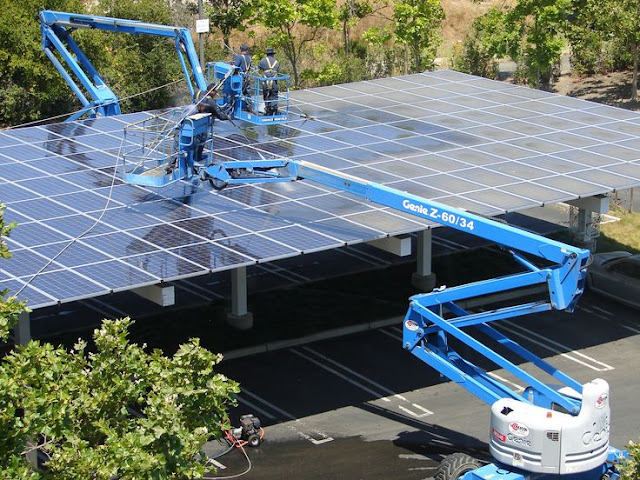Solar shingles work in a similar way to solar panels—they both absorb the sun’s rays, converting the light to thermal or electrical energy.
1. Solar roof systems' advantages
- Energy-Efficient - Renewable and Free Energy
- Lessen Electrical Bills
- Durable & Less Maintenance
- Weather Resistant including snow and ice-melting
- Reduces Fossil Fuel Use; Eco-Friendly
- Sleek and Modern
- Easy Installation
The urban environment provides a large amount of empty rooftop spaces and can inherently avoid the potential land use and environmental concerns.
>> Related Post: Understand why your roof leaks.
Estimating rooftop solar insolation is a multi-faceted process, as insolation values in rooftops are impacted by the following:
- Time of the year
- Latitude
- Weather conditions
- Roof slope
- Roof aspect
- Shading from adjacent buildings and vegetation
There are various methods for calculating potential solar PV roof systems including the use of Lidar and orthophotos.
Sophisticated models can even determine shading losses over large areas for PV deployment at the municipal level.
Components of a rooftop solar array:
The following section contains the most commonly utilized components of a rooftop solar array.
>> Related Post: How To Compare The Best Residential Roof Systems?
Though designs may vary with roof type (e.g. metal vs shingle), roof angle, and shading concerns, most arrays consist of some variation of the following components
- Solar Panels produce carbon free electricity when irradiated with sunlight. Often made of Silicon, solar panels are made of smaller solar cells which typically number 6 cells per panel. Multiple solar panels strung together make up a solar array. Solar panels are generally protected by tempered glass and secured with an aluminum frame. The front of a solar panel is very durable whereas the back of a panel is generally more vulnerable.
- Mounting clamps generally consist of aluminum brackets and stainless steel bolts that secure solar panels to one another on the roof and onto the rails. Clamps often vary in design in order to account for various roof and rail configurations.
- Racking or rails are made of metal and often lie in a parallel configuration on the roof for the panels to lie on. It is important that the rails are level enough for the panels to be evenly mounted.
- Mounts attach the rails and the entire array to the surface of the roof. These mounts are often L brackets that are bolted through flashing and into the rafters of the roof. Mounts vary in design due to the wide range of roof configurations and materials.
- Flashings are a durable metal plate that provide a water resistant seal between the mounts and roof surface. Oftentimes, caulk is used to seal the flashing to the roof and it resembles a metal roof shingle.
- DC/AC wiring for inverters connect wires between panels and into a micro inverter or string inverter. No cables should touch the roof surface or hang from the array to avoid weathering and the deterioration of cables.
- Micro inverters are mounted to the bottom of the panel and convert DC power from the panels into AC power that can be sent into the grid. Micro inverters allow for the optimization of each panel when shading occurs and can provide specific data from individual panels.
2. Common types of solar roof
There are different options to install solar roofs but the most common are:
2.1. Solar Shingles
Solar shingles are easier to install as they are the same size as the common shingles, they are more durable as they are part of the roofing system and since they are also a roofing material, it is more efficient as it takes more sunlight in different angles.
The well-known companies that deliver quality solar shingles are Tesla, CertainTeed, SunTegra, and Luma.
2.2. Solar Tiles
One of the newest inventions is solar tiles. Just like solar shingles, these are also the same sizes as the common tile roof and are more durable as they are created to be weather resistant.
They perform well during heavy winds and hail as they do not need to be bolted, unlike the conventional roofing material. The companies that are providing solar tiles in the market are Tesla, GB Sol, Solarcentury, and Solecco.
Solar Roof works in a way that they absorb the sun rays and convert the light to thermal or electrical energy that you can use to power your home that lessening your bills and also reducing your carbon footprint.
>> Related Post: What are the Varieties of Roofing Services That Are Available?
2.3. Solar Panel
Solar Panels have been in the market for a long time compared to solar shingles and tiles.
Panels are put atop your roof which you need to reinforce because of their additional weight.
However, some roofing materials are brittle like the clay tile roofs.
The best roofing materials you can use for solar panels are concrete tiles, asphalt shingles, and metal roofs.
Conclusion
Swadley Roof Systems offers the best roofing services in the Houston, Austin, San Antonio and Dallas area.
- Tel: 832-559-8463
- Email: info@swadleyroofsystems.com
- Location: 17413 FM 2920 Suite O Tomball, TX 77377
- Facebook: Fanpage Swadley Roof Systems
- Website: https://www.swadleyroofsystems.com/







0 Comments
Đăng nhận xét